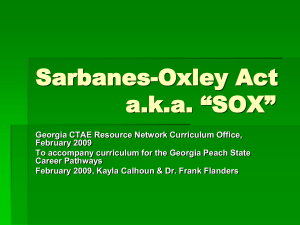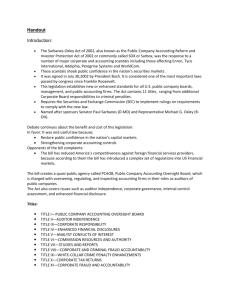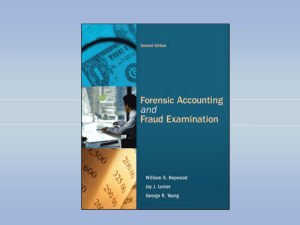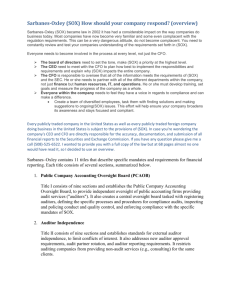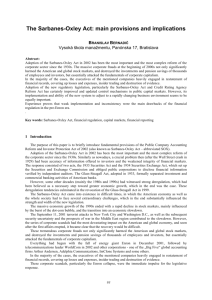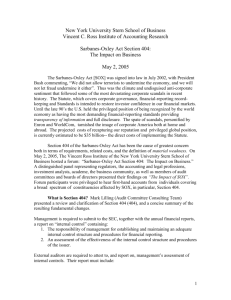Sarbanes-Oxley Act
advertisement
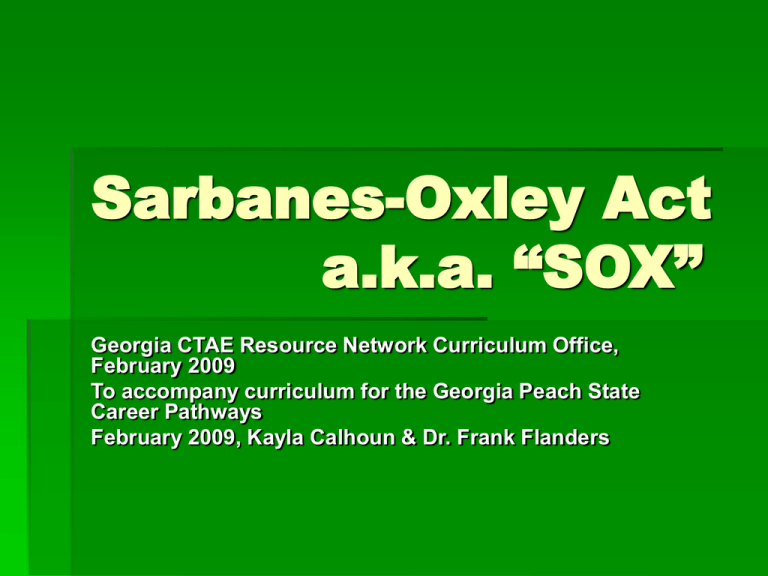
Sarbanes-Oxley Act a.k.a. “SOX” Georgia CTAE Resource Network Curriculum Office, February 2009 To accompany curriculum for the Georgia Peach State Career Pathways February 2009, Kayla Calhoun & Dr. Frank Flanders Enduring Understanding The Sarbanes-Oxley Act was enacted to establish new or enhanced standards for U.S. public company boards, management, and public accounting firms. Essential Questions Why was the Sarbanes-Oxley Act needed? How does the Sarbanes-Oxley Act protect stockholders and institutions? Objectives Describe the events that caused the passing of the Sarbanes-Oxley Act. Relate the Sarbanes-Oxley Act to accounting. Explain the goals of the Sarbanes-Oxley Act. Describe each of the 11 titles of the Sarbanes-Oxley Act. What is SOX? Also known as the Public Company Accounting Reform and Investor Protection Act of 2002 Created by US Senator Paul Sarbanes (D-Maryland) and US Congressman Michael Oxley (R-Ohio) Signed into law July 30, 2002 Most dynamic securities legislation since the Securities and Exchange Acts of 1933 and 1934 Purpose of SOX Establish new or enhanced standards for U.S. public company boards, management, and public accounting firms Relation to Accounting Bad accounting procedures, both intentional and non-intentional, led to the collapse and subsequent investigation of several large companies Public outrage led Congress to pass SOX to regulate audits of public company accounting procedures and hopefully prevent false financial reports Relation to Accounting, continued… Companies that do not follow standard accounting procedures may use methods that mislead investors about the financial health of the company. These practices range from just unethical to illegal. Why was SOX passed? Failure of Boards of Directors and executives to double-check financial records Intentional misrepresentation of financial status Loans from major banks to risky companies hurt bank investors and encouraged others to make risky investments in those companies Misrepresentation of company earnings caused stockholders to make seemingly good investments that cost them large sums of money Why was SOX passed?, continued… Auditor conflicts of interest Some auditing firms provided consulting services to the companies they audited. Proper auditing procedures, such as challenging a company’s accounting procedures, could damage the client relationship under the consulting agreement. This caused bad accounting practices and misrepresentation of financial information to go unchecked, leading to the collapse of several companies, like Enron. Goals of SOX Regain public confidence in markets Improve corporate governance Increase executive accountability Increase efforts to prevent, detect, investigate and remediate fraud and misconduct Title I – Public Company Accounting Oversight Board Created as a non-profit organization to oversee audits of public companies Under the authority of the Securities Exchange Commission (SEC) Comprised of 5 appointed members w/ a max of 2 CPA’s Duties: Register existing public accounting firms which prepare audits for publicly traded companies Audit the auditors Establish and amend rules and standards (in cooperation with other standard setters) Try and penalize registered public accounting firms who fail to comply with the rules Title II – Auditor Independence Prohibits registered public accounting firms from performing non-audit services for companies they audit Prevents conflicts of interest Title III – Corporate Responsibility CEOs and CFOs must certify accuracy Forfeit bonuses and profits if information is misrepresented Title IV – Enhanced Financial Disclosures Forbids most personal loans to chief executives Disclosure of code of ethics for senior financial officers Disclosure of members of company audit committee Should include at least one financial expert Title V – Analyst Conflicts of Interest Requires registered securities associations to adopt rules that prevent conflicts of interest Ex: Recommendations of analysts in research reports Title VI – Commission Resources and Authority Increased SEC budget to $780 million $98 million used to hire 200 employees to oversee auditors SEC has the authority to investigate and punish violators of security law Title VII – Studies and Reports US Comptroller General to conduct a study about the consolidation of public accounting firms Also conduct investigation of security law violations in the cases of Enron, WorldCom, etc. Title VIII – Corporate and Criminal Fraud Accountability To knowingly create, destroy, or manipulate documents or impede federal investigations is considered a felony Punishment = Fines, maximum 20 years in prison, or both Audit reports should be kept for 5 years Whistleblower protection Title IX – White-collar Crime Penalty Enhancements CEOs and CFOs must certify that financial statements are accurate representations of the company’s condition Punishment = Max $5 million fine and/or max 20 year sentence SEC may ban anyone convicted of a security crime from holding an executive position at a public company Title X – Corporate Tax Returns Federal income tax returns must be signed by the Chief Executive Officer (CEO) of the company Title XI – Corporate Fraud Accountability Destroying/altering evidence or otherwise obstructing securities fraud proceedings may be punished with a fine and/or up to 20 years in prison SEC may freeze payments to accused individuals Any retaliation to whistleblowers is subject to fines and/or 10 years imprisonment Summary The Sarbanes-Oxley Act of 2002 was passed to regain public confidence in the stock market following a string of major accounting fraud cases involving public companies. A plan to accomplish this objective is outlined in 11 titles, which: Prohibit conflicts of interest Increase corporate accountability Increase accounting transparency Form an oversight board to enforce the new rules Exam Questions 1. The Sarbanes-Oxley Act was passed in: a. 1935 b. 1974 c. 1999 d. 2002 2. What events led to the passing of SOX? a. Collapse of the auto industry b. A string of accounting scandals at public companies c. Great Depression d. Discrimination in the accounting profession Exam Questions, continued… 3. What government institution was established by SOX to oversee auditors? Answer 4. The Public Company Accounting and Oversight Board is under the authority of: a. North Atlantic Treaty Organization (NATO) b. Food and Drug Administration (FDA) c. Securities Exchange Commission (SEC) d. US Treasury 5. Name 4 titles of the Sarbanes-Oxley Act. Answer Exam Questions, continued… 6. According to Title X, who should sign the company tax return? a. Chief Executive Officer (CEO) b. President of External Accounting Firm c. Chief Financial Officer (CFO) d. Company’s Head of Accounting 7. What events involving major public companies led to the passing of SOX? a. Intentional misrepresentation of company financial records b. Auditor conflicts of interest c. Risky loans from banks based on false earnings d. all of the above Exam Questions, continued… 8. What is the criminal penalty for violation of SOX? a. life in prison b. fines and/or maximum 20 years in prison c. maximum 5 years in prison d. tax increase 9. True/False: Under SOX, auditors are not allowed to provide non-audit services (consulting) to the companies they audit. 10. True/False: SOX does not apply to privately held companies.
